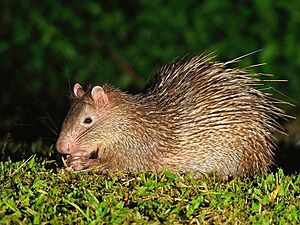Asiatic brush-tailed porcupine facts for kids
Quick facts for kids Asiatic brush-tailed porcupine |
|
|---|---|
 |
|
| Conservation status | |
| Scientific classification | |
| Genus: |
Atherurus
|
| Species: |
macrourus
|
 |
|
| Synonyms | |
|
Hystrix macroura Linnaeus, 1758 |
|
The Asiatic brush-tailed porcupine (Atherurus macrourus) is a type of rodent that belongs to the porcupine family. It gets its name from the special bristles on its tail that look like a brush! You can find these interesting animals in many parts of Asia, including China, Bhutan, India, Laos, Malaysia, Myanmar, Thailand, and Vietnam.
Contents
About the Asiatic Brush-tailed Porcupine
This porcupine is known for its unique appearance and habits. It's a fascinating creature that plays a role in the ecosystems where it lives.
Where They Live
Asiatic brush-tailed porcupines prefer to live in warm, wet forests, especially in mountains. They like places with lots of plants, like thick bushes, bamboo, and palm trees. These porcupines are nocturnal, which means they are active mostly at night. They are also fossorial, meaning they spend a lot of time digging and living underground.
Family Life
These porcupines dig burrows, which are like underground tunnels or homes. Sometimes, up to three porcupines might share the same burrow. Female porcupines usually have one or two babies each year. After being pregnant for about 100 to 110 days, they give birth to a single young one.
How They Behave
Studies using special cameras have shown that these porcupines usually look for food at night. They are most active in the three hours before midnight. To stay safe from predators, they change their habits when the moon is full and bright. On those nights, they prefer to search for food only during dawn and dusk, when it's not as bright.
Keeping Them Safe
The Asiatic brush-tailed porcupine is considered one of the rarer porcupines in South Asia. Because of this, it is protected by laws in some countries. For example, in India, it is protected under the Indian Wildlife (Protection) Act. This helps to make sure these unique animals can continue to live safely in their natural homes. They are also found in many protected areas across Southeast Asia.


